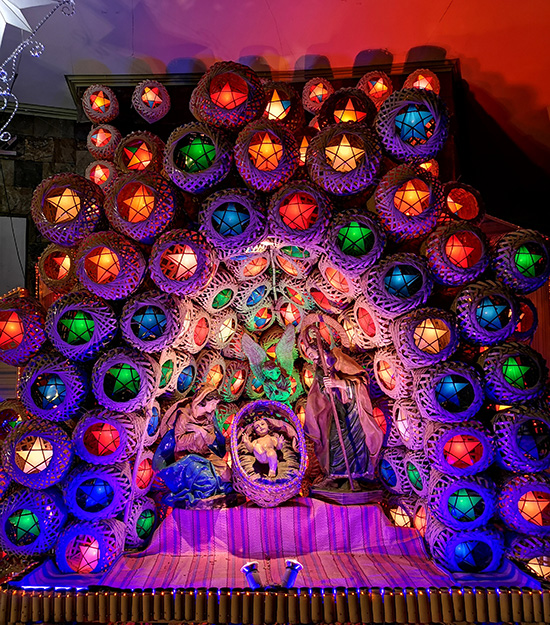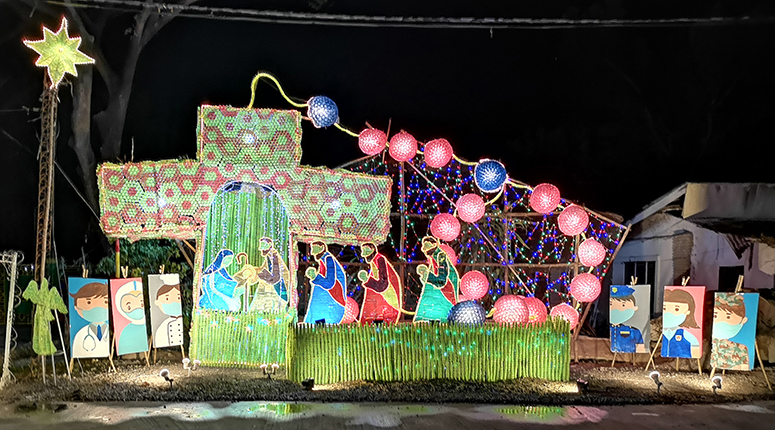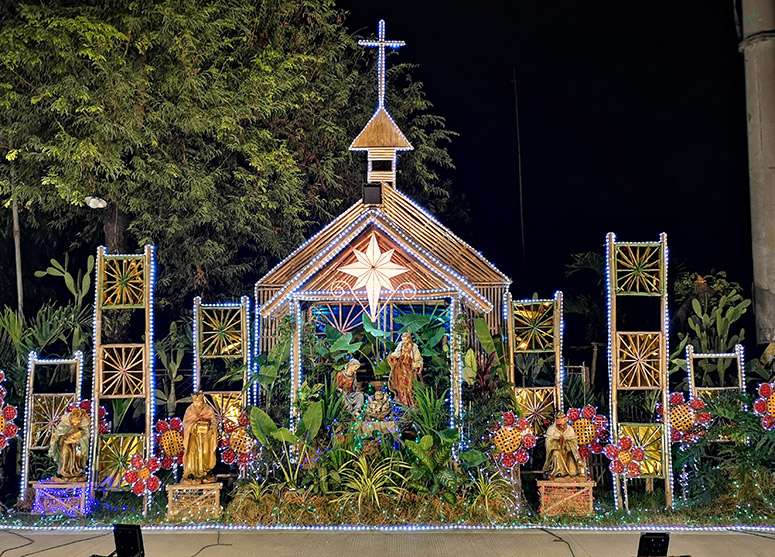Belenismo in pandemic
At a time when Filipinos are in the dark and anxiously looking for a reprieve from the seemingly never-ending and stressful disasters this year, the annual Belenismo sa Tarlac pushed through and formally opened with 32 finalists last Nov. 6.
Rather than letting the string of unfortunate events spoil the remaining months of 2020, the indomitably spirited Tarlaqueños decided to celebrate by pushing for the much-awaited event to happen.
And as if the coronavirus pandemic, and the two back-to-back typhoons Rolly and Siony that battered Luzon in late October and early November respectively, weren’t enough, typhoon Ulysses ravaged central Luzon just two days before the final judging scheduled on Nov. 14, destroying most of the 32 entries.
In this year’s tableaux, the entries pay homage to the deeds and sacrifices of our frontliners who are still continuously fighting the spread of the dreaded coronavirus.
Last Nov. 21, after the nativity displays had been rebuilt and resuscitated in no time, my Belenismo family of judges drove to and converged in Tarlac as has been our tradition and the start of our Christmases for the past 13 years.
Belenismo sa Tarlac was founded in 2007 by the late Rev. Fr. Alex Bautista of the Diocese of Tarlac together with the Tarlac provincial government, Tarlac Convention and Visitors Bureau, and the Tarlac Heritage Foundation headed by the indefatigable mother-and-daughter tandem of Doña Ysabel Cojuangco and Dr. Isa Cojuangco Suntay. The Belenismo project is also a part of the La Federacion Española de Belenistas, a non-profit organization founded in 1963 with a thrust to promote and disseminate the art of Nativity scenes.
“Each year the Belenismo showcases the unique talent and artistry of Tarlaqueños. This year is different because we must conform with the IATF guidelines because of the COVID-19 pandemic. The cooperation of and unity of the Filipinos are different. I think they want to say that we have faith and we leave our faith to God. Be proud and we must remember that whatever happens, the birth of Christ in the manger will never lose its value to us, wherever we are,” said Dr. Suntay during the final judging.
“Belenismo is a festival that can go on despite the quarantine restrictions. Everyone is welcome but health and safety protocols must be observed,” added Suntay.
In this year’s tableaux — aptly themed “We Heal As One” — the entries pay homage to the deeds and sacrifices of our frontliners who are still continuously fighting the spread of the dreaded coronavirus.
Regardless of how troublesome life under the pandemic may appear, good things have remained and emerged — Filipinos remained hopeful and never lost faith, joined together to help others and focused to function as one nation.
The winning entries this year were judged based on the theme and composition, which feature intricacy of design, quality of workmanship; choice of colors; use of materials; image of the Christmas crèche, and the prayer before it; lighting, which provides a solemn but festive atmosphere and focuses on the significant points of the display; and overall impact, which leaves a lasting impression on viewers.
The municipalities of San Clemente and Moncada emerged in this year’s edition as winners of the Grand Municipal Category.
San Clemente town, now in the Hall of Fame circle, produced a creche called “Light and Life” that is made out of buho (sympodial bamboo) poles soaring 42 feet high, along with anahaw leaves, banana stalks, and other recycled materials, drawing inspiration from the famed lighthouse of Batanes.
Moncada town’s belens have always been grand and something to look forward to each year. For this edition, its belen carries the theme “The Savior Has Come, We Heal As One” to convey a message of shared responsibility to heal as one town or one nation. Made of G.I. sheet roofing materials, it pays tribute to the heroic frontliners in this time of pandemic. An angel with spread-out wings (made from painted metal sheets) hovers above the holy family.
Winning top spot in the Grand Non-Municipal Category, the Philippine Army’s “Hope In The Time of COVID” belen draws inspiration from the rainbow with seven distinct colors blending harmoniously to form a magnificent show of pigment which stands as a symbol of God’s mercy, peace and hope, especially in these dark and trying times.
“Regardless of how troublesome life under the pandemic may appear, good things have remained and emerged — Filipinos remained hopeful and never lost faith, joined together to help others and focused to function as one nation,” the Philippine Army team declared.

Winners in the Church Category are Saint Michael Archangel Parish, San Lorenzo Ruiz Parish, and St. Catherine of Alexandria Parish — first, second, and third place respectively.
San Lorenzo Ruiz’s belen is made with an assemblage of colorful hen baskets, each with a lit parol inside to symbolize the frontliners. The belen is placed near the church’s main entry as a way to encourage people to go back to the church, especially in these most trying times.

Gerona’s St. Catherine of Alexandria Parish created a Holy Rosary nativity scene that is made with over 15,000 plastic bottles and plastic cups, aimed at sending an eco-friendly message while also encouraging Filipinos to pray for our courageous frontliners of the COVID-19 pandemic. Bamboo slats, dried palm leaves and other recycled objects were also used to represent the birth of Jesus in the manger.
San Roque Parish Church’s belen never fails to amaze us. The parish’s nativity scene this year is sleek and almost minimalist and symmetrical in execution — drawing inspiration from a honeycomb. It features 12 cells to represent the 12 disciples: 11 hexagonal wax cells made out of solihiya weave and one cell made in a different shape, material and placement. A bigger central hexagonal cell features the Holy Family. Hovering over the cells are 17 bees made of baskets, representing the 17 towns of Tarlac province.

Grand Winner in the Community Category is “Belen Ning Macara.” Set against a backdrop of a church made with buho poles and latticed bamboo panels, “Belen Ning Macara” worked on a “plantdemic” theme to satiate the hearts of green-thumbed plantitos and plantitas, and to commemorate the birth of Jesus in the manger. Symbolizing Filipinos’ resiliency, this crowd favorite belen features a predominantly green color with the use of fresh plants.
McDonald’s Capas’ winning belen in the Monumental Category is titled “Pit Stop” is also dedicated to all the courageous frontliners for their continuous work in keeping everyone out of harm’s way. Its main feature is the crown of Virgin Mary made from recycled birthday party balloon sticks sprayed with gold color. Completing the backdrop are 200 pieces of tinapa bitses spray painted in bright colors. Hand-painted images of frontliners are also featured behind the Holy Family.
Many of the belens were not spared from the wrath of Ulysses two days before the original final judging night but Tarlaqueños were able to rebuild, thanks to their desire and bayanihan spirit. This year’s edition of Belenismo truly is a heartwarming example of how people are continuing to come together while staying apart.
* * *
The Tarlac Heritage Foundation welcomes spectators to drive by the belens and requests that masks and face shields be worn and social distancing be observed, as well as follow all the other protocols mandated by the Inter-Agency Task Force on Emerging Infectious Diseases.
Belenismo sa Tarlac 2020 runs until Jan. 6, 2021. For more information, visit their Facebook Page: https://www.facebook.com/BelenismoSaTarlac.


